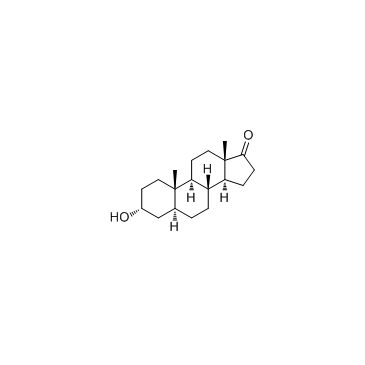Androsterone

Androsterone structure
|
Common Name | Androsterone | ||
|---|---|---|---|---|
| CAS Number | 53-41-8 | Molecular Weight | 290.440 | |
| Density | 1.1±0.1 g/cm3 | Boiling Point | 413.1±45.0 °C at 760 mmHg | |
| Molecular Formula | C19H30O2 | Melting Point | 180-185ºC | |
| MSDS | Chinese USA | Flash Point | 176.4±21.3 °C | |
| Symbol |


GHS07, GHS08 |
Signal Word | Danger | |
|
Silica-based nanofibers for electrospun ultra-thin layer chromatography.
J. Chromatogr. A. 1364 , 261-70, (2014) Nanofibrous silica-based stationary phases for electrospun ultra-thin layer chromatography (E-UTLC) are described. Nanofibers were produced by electrospinning a solution of silica nanoparticles dispersed in polyvinylpyrrolidone solutions to create composite s... |
|
|
Chemical genetics reveals a complex functional ground state of neural stem cells.
Nat. Chem. Biol. 3(5) , 268-273, (2007) The identification of self-renewing and multipotent neural stem cells (NSCs) in the mammalian brain holds promise for the treatment of neurological diseases and has yielded new insight into brain cancer. However, the complete repertoire of signaling pathways ... |
|
|
Next-generation steroidogenesis inhibitors, dutasteride and abiraterone, attenuate but still do not eliminate androgen biosynthesis in 22RV1 cells in vitro
J. Steroid Biochem. Mol. Biol. 144 Pt B , 436-44, (2014) • Dutasteride and abiraterone were evaluated for inhibition of steroidogenesis. • Bypass mechanisms arise in the presence of abiraterone to form DHT. • Dutasteride inhibits T and DHT effectively in vitro. • Abiraterone inhibits AR and steroidogenesis leading ... |
|
|
Pomegranate extracts impact the androgen biosynthesis pathways in prostate cancer models in vitro and in vivo.
J. Steroid Biochem. Mol. Biol. 143 , 19-28, (2014) Castration-resistant prostate cancer (CRPC) remains largely dependent on androgen receptor (AR). Residual tissue androgens are consistently detected within CRPC tumors and play a critical role in facilitating AR-mediated signaling pathways which lead to disea... |
|
|
A quantitiative LC-MS/MS method for the measurement of arachidonic acid, prostanoids, endocannabinoids, N-acylethanolamines and steroids in human plasma.
J. Chromatogr. B. Analyt. Technol. Biomed. Life Sci. 976-977 , 6-18, (2015) Free arachidonic acid is functionally interlinked with different lipid signaling networks including those involving prostanoid pathways, the endocannabinoid system, N-acylethanolamines, as well as steroids. A sensitive and specific LC-MS/MS method for the qua... |
|
|
An updated steroid benchmark set and its application in the discovery of novel nanomolar ligands of sex hormone-binding globulin.
J. Med. Chem. 51 , 2047-56, (2008) A benchmark data set of steroids with known affinity for sex hormone-binding globulin (SHBG) has been widely used to validate popular molecular field-based QSAR techniques. We have expanded the data set by adding a number of nonsteroidal SHBG ligands identifi... |
|
|
Impact of induced fit on ligand binding to the androgen receptor: a multidimensional QSAR study to predict endocrine-disrupting effects of environmental chemicals.
J. Med. Chem. 48 , 5666-74, (2005) We investigated the influence of induced fit of the androgen receptor binding pocket on free energies of ligand binding. On the basis of a novel alignment procedure using flexible docking, molecular dynamics simulations, and linear-interaction energy analysis... |
|
|
Genetic mapping of targets mediating differential chemical phenotypes in Plasmodium falciparum.
Nat. Chem. Biol. 5 , 765-71, (2009) Studies of gene function and molecular mechanisms in Plasmodium falciparum are hampered by difficulties in characterizing and measuring phenotypic differences between individual parasites. We screened seven parasite lines for differences in responses to 1,279... |
|
|
Anticancer activity of a novel selective CYP17A1 inhibitor in preclinical models of castrate-resistant prostate cancer.
Mol. Cancer Ther. 14(1) , 59-69, (2015) VT-464 is a novel, nonsteroidal, small-molecule CYP17A1 inhibitor with 17,20-lyase selectivity. This study evaluates the anticancer activity of VT-464 compared with abiraterone (ABI) in castrate-resistant prostate cancer cell lines and xenograft models that a... |
|
|
Bile acids alter male fertility through G-protein-coupled bile acid receptor 1 signaling pathways in mice.
Hepatology 60(3) , 1054-65, (2014) Bile acids (BAs) are signaling molecules that are involved in many physiological functions, such as glucose and energy metabolism. These effects are mediated through activation of the nuclear and membrane receptors, farnesoid X receptor (FXR-α) and TGR5 (G-pr... |